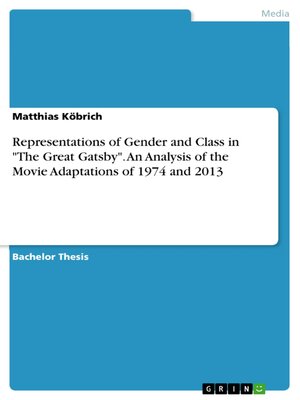Representations of Gender and Class in "The Great Gatsby". an Analysis of the Movie Adaptations of 1974 and 2013
ebook
By Matthias Köbrich

Sign up to save your library
With an OverDrive account, you can save your favorite libraries for at-a-glance information about availability. Find out more about OverDrive accounts.
Find this title in Libby, the library reading app by OverDrive.



Search for a digital library with this title
Title found at these libraries:
| Library Name | Distance |
|---|---|
| Loading... |
Bachelor Thesis from the year 2014 in the subject Film Science, grade: 1.3, Friedrich-Alexander University Erlangen-Nuremberg (American Studies), language: English, abstract: A tendency in the realm of gender studies has been to mainly concern oneself with gender, whereas the same can be claimed in terms of class analysis showing a tendency towards primarily and exclusively dealing with class. This study tries to combine both fields in an attempt to not only expose how present forms of masculinity are established but also how these forms interact with 'class'. In addition to Crenshaw's 'intersectionality' theory, Pyke's concept of 'interpersonal power' and Connell's theory of 'hegemonic masculinity' will be dealt with. The synergy between masculinity and 'class' will be scrutinized by means of two movie adaptations of "The Great Gatsby" (1974/2013). It will be shown that factors such as social and geographical mobility, career, and the need or ability to display class-marked objects, as well as the male body can be identified as producing and helping to maintain multiple forms of class-based masculinity, as well as shaping and changing these masculinities.







